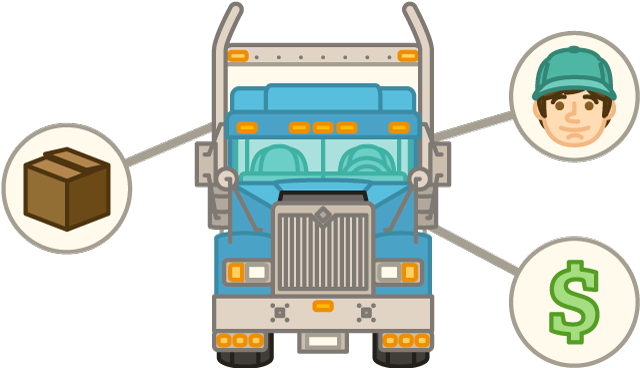
We’ve all been there: that moment during a move when a third (or fifth, or eighth) trip has to be made to the hardware store, the corner grocery or the 24-hour mart to pick up something — whether it’s more boxes, another roll of tape, or some random thing we never imagined we’d need, but all of a sudden it’s become a necessity. And for some reason (see: “Murphy’s Law”), it always seems to happen in the middle of the night or the moment before the moving truck pulls into the driveway, ready to rock and roll before you are.
To keep that moment from reoccurring, the Moveline team has put together a short and sweet checklist of packing essentials to stock up on before a move. Since we’re moving experts, we’ve got more than a few tips to make a relocation run smoothly, whether it’s a ZIP code away or clear across the country. So, trust us when we say you very likely need the following:
Moving essentials:
- An abundance of regular boxes (obviously, unless the movers are packing for you)
- Eco-friendly rentable boxes, if you want to reduce your move’s environmental impact
- Specialty containers for items you’re concerned about (wine glasses, fine china, family heirlooms)
- Bubble wrap and/or packing paper to protect breakables and stabilize not-quite-full boxes
- More tape than you think you’ll need; you can always use the extra stuff later, in your new home
- More magic markers than you think you’ll need; it’s no picnic when they run dry or get misplaced
- Photos of the back of your computer and TV, where re-attaching wires could otherwise get tricky
- A suitcase with several days’ worth of clothing, depending on how your wardrobe is being moved
- Bottled water for the day of the move (eco-friendly option: a gallon or two, plus reusable cups)
- Portable snacks, since you really shouldn’t run out for grub during loading and unloading
- Items set aside that need to be reachable on moving day (i.e., a “first night box;” see our handy list
- Arrangements made for kids and pets, if at all possible (read our reasons why)
No matter the circumstances of your move, Moveline can help. For free, we demystify the inventory process and get fair, accurate moving quotes from reputable movers on your behalf; better still, we assign you a Move Captain to oversee your entire relocation and make sure it runs smoothly. Moving is stressful enough on its own, so don’t go it alone. Let us help. We’ll remove the headache.

Few topics scream “adulthood” and “commitment” more loudly than real estate, and to put it mildly, the market — and society in general — isn’t what it was 50 years ago. Gone are the days when everyone was expected to get married and invest in a home before completing the first quarter-century of life… and for more reasons than one, perhaps that’s a good thing.
At Moveline, we’ve worked with folks of all ages and backgrounds with all sorts of careers and personal lives, and no two cases are exactly alike. There are some mile markers that signify readiness for real estate investing, though, so we’ve put together a quick guide to help you determine whether or not it might be time for you to buy your first home
Your finances are in fantastic shape
First and foremost, lenders want to be assured that they’ll receive their payments like clockwork — on time and in full. If your credit rating is low, you’re up to your ears in debt, your income is unsteady and/or you’ve only got a tiny bit of money saved up for a rainy day, chances are, you’re not a viable candidate for homeownership right now.
On the other hand, if your financial house is in order, you might be ready to sink some of it into an actual house. Your financial institution can review your profile and determine what kind of loan, if any, you might qualify for, which should help set the parameters for the type of home you’ll be shopping for. Particularly if you’ve built a longstanding relationship with your bank or credit union, you should be able to ask frank questions about exactly what needs to be done to put you in the proper position to invest.
You have realistic expectations
Simply having the remote perenially tuned to HGTV won’t arm you with an accurate set of data when it comes to knowing what homes cost in your city or town (or, for that matter, the place you might be relocating to if you’re considering settling down somewhere else). Do your research through publicly-accessible sites like Zillow and Trulia, and make sure you have a good idea of what a monthly mortgage payment would be with an acceptable mortgage rate over a comfortable period of time.
Also, keep in mind that renovation budgets can inflate quickly, so if you’re looking into fixer-uppers, be sure to do your homework on the potential amount you might be dropping on those floors, that yard, those pipes and whatever else might need to change in that house with “good bones” and “lots of potential.”. Remember, real estate professionals need to make a sale off of you, so an agent might not be the best person to ask for advice in the beginning of your planning process; again, your financial institution should have qualified staff ready to walk you through any questions you might have about the first-time homebuyer process — particularly when it comes to your cash. And of course, there’s no shortage of online resources for buying a home.
You can make a sizeable down payment
Speaking of cash, a large down payment can obviously save you a world of hurt on a monthly mortgage payment and potentially give you more power during the purchasing process. If your credit is healthy, your debts are minimal to nonexistent, and you’re mentally prepared to purchase a home but don’t quite have a comfortable amount of money saved for a down payment, organizations like Kiplinger’s offer great guides and worksheets on saving moneytoward large purchases like a home.
You really, really want to settle down
More than anything, purchasing a home is a big deal, emotionally as well as financially. With more than a solid 35 percent of the American population renting, The Atlantic Cities reports that three in five adults in the U.S. believe that “renters can be just as successful as homeowners in achieving the American Dream.” So be sure that if you’re indeed thinking of buying a home, you’re doing it for your own gratification and not to appease anyone else, like parents, co-workers or that secret nemesis you’ve been silently competing with since high school.
The emotional, fiscal and physical commitment of buying a home — particularly for the first time — is nothing to be taken lightly; while it’s certainly something to be celebrated, it’s not something to be done on a whim. Do your homework, take your time, and make sure you’re properly motivated and prepared to spend a good deal of time and energy on making your next home officially yours.
Whether you’ll be renting or owning your next home, let Moveline help with the moving process. By simplifying your inventory process and assigning a Move Captain to secure fair,accurate quotes from reputable moving companies on your behalf, we’ll oversee the entire process and take the headache out of ot completely. Best of all, our services are free. So don’t go it alone. Let Moveline help you #movebetter. Get started on our homepage to learn how we can make life easier during your next transition.

Here at Moveline, we’ve overseen quite a few moves — down the street, across the country and everything in between. Undoubtedly, moving with young kids in tow carries a special set of challenges and considerations, but with a little pre-planning, it can be an adventure instead of a debacle.
Check out this video of a sweet couple, Corey and Emily, whom we helped move to Las Vegas with a four year-old and a one year-old in tow. The takeaway: remembering little things like nap schedules and feeding times can make all the difference in the world when it comes to getting a family from point A to point B without losing any sanity in the process.
If you’re moving sometime soon — kids or no kids — let Moveline give you a hand. We specialize in getting you the best deal possible from reputable movers and overseeing your move every step of the way. The best part: it’s free — just like all the best things in life. So don’t go it alone. Let Moveline help. Visit our homepage to start planning your move, hassle-free.

Step back in time
If you don’t mind spending some time getting everything “just so,” you’re likely in for a treat: there’s certainly no shortage of secondhand stores and flea markets in even the most suburban and rural of neighborhoods. While the most truly impressive clusters of vintage shops are typically found in places like New York, San Francisco, Seattle and Austin, don’t underestimate the power of a little ingenuity and patience. Flea markets and estate sales can fill your Saturdays with treasure-hunting adventures as you decorate your space with discounted goods. And of course, online resources like good ol’ Craigslist make budget-minded shopping excursions possible from the comfort of your couch.
If you’re too short on time or patience for Craigslist fails and don’t want to make a sport out of personally perusing antiques and lightly-used home accents, never fear; our friends at Apartment Therapy have plenty of online vintage shopping suggestions for your casa. (Ah, the interwebs… how we love you.)
Get creative
When decorating your space, less can be more, and it’s not necessary to go overboard, filling every nook and cranny with decoration. Just a few thoughtfully arranged touches — well-placed candles in a fireplace you don’t use, personal photographs artfully tacked to a wall in a cool pattern, or even simple paper lanterns strategically hung from a corner of the room — can provide more warmth and character than any expensive designer pillows ever could. Ask any truly creative designer about great use of space, and each one should agree: the greatest way to decorate a space is to let its inhabitants’ personality shine through, loud and clear. And that rarely means deep pockets; it often means ingenuity, like you’ll find here, here and here.
Show your true colors
Maybe you’re the get-it-over-and-done-with-quick type — someone to whom the sentimentality of objects doesn’t really apply. By far, the most straightforward way to impact the look of a home is to use color in big, bold ways — and the simplest way to apply lots of color without lots of time spent mulling over fabrics, knickknacks and tchotchkes is to paint the walls. And the biggest money saver of all in this scenario: putting on some sweatpants, rolling up your shirtsleeves and doing the work yourself.
Pick a different color for each room, or choose one color for the central living space and one separate color for the rest of the apartment (with the landlord’s blessing, of course, or at least the knowledge that you’ll be painting right back over it before you move out if you want to see your security deposit again). For greatest results, leave baseboards, doors and chair railings (if you have them) off-white for a classic contrast. And don’t forget the painter’s tape and drop cloths — they’re essential.
Chalk it up
If you’re particularly artistic or just love a good bit of nostalgia, chalkboard paint is a fun and affordable way to cover your walls (okay, perhaps not all of them — maybe just one or two), leaving open an endless array of options for decor; you can write a favorite quote in huge chalk letters one month and spend the next filling the room with doodles, or notes to yourself, or a non-stop game of tic-tac-toe with roommates. All it takes is a few cans of Rustoleum from the local hardware store and you’re good to go.
Inspired? Want more? Check out the Moveline blog archives for more budget-friendly ideas on making a rental feel like home. And if you’re moving in the near future, let Moveline help. By taking the reins, getting quotes on your behalf and overseeing your entire move, we take the stress and headache out of the process entirely — for free. So don’t go it alone. Partner up with us and make your move easier than you ever imagined.

Planning a move but overwhelmed at the prospect of hiring the right mover at the right price? You’re not alone. The U.S. Census bureau estimates that, each year, about 12 percent of the country’s population moves — that’s more than 30 million people relocating from one home to another in the next 12 months. Needless to say, while movers want your business, if you don’t know your rights and use the resources that are available to you, it’s not likely you’ll get the best possible deal. Since knowledge is power, we’re arming you with a smart, quick rundown on choosing a mover that’s right for you.
Understand that timing is everything
The moving industry is a fast-paced, mileage-accruing mega-machine, relocating up to 12 percent of the U.S. population each year. That’s an awful lot of people, so imagine the extra work and expense required to accommodate last-minute requests — particularly where cross-country moves are concerned.
For the best rates and greatest amount of options, start your planning process early — several months is ideal — and free yourself up for the opportunity to work with whatever mover you choose, rather than letting your last-minute circumstances choose for you.
Get fair, accurate quotes
The inventory process is a make-it-or-break-it element of any moving budget. While you may estimate, for example, that you need 30 boxes and a couple hours of professional movers’ time to get the job done, that super-affordable-sounding quote won’t be so super if you ultimately wind up needing 60 boxes and twice as many hours of moving time. In fact, the cost can more than double over a simple, honest miscalculation.
That’s one of the many reasons we founded Moveline — to take the guesswork out of moving and save everyone a little sanity. We’ve developed special software to demystify the inventory process and obtain reasonable, relevant quotes that won’t change (i.e., spike) when moving day finally arrives. Take a spin through our homepage and watch our short video to learn about our Move Captains, our use of video to avoid in-person consultations with movers, and the general process of working with Moveline.
Know your rights & responsibilities
First and foremost when it comes to moving, while the customer may always be right in theory, the law can sometimes state otherwise. The good news is, learning your rights doesn’t have to be a murky process.
Although moving companies are require to share a rights & responsibilities booklet with you (published by the US Department of Transportation), you don’t have to wait on them; you can read it beforehand and get familiar with the basics of movers’ rights.
Don’t get swindled
Although Moveline is free for customers, should you choose to go it alone, be sure to check out the Federal Motor Carrier Safety Administration’s tips for choosing a reputable mover.
Most importantly, make sure you work with a company that’s licensed by the proper authority: for state-to-state moves, the FMCSA is the licensing authority, while within an individual state, licensors vary. And although it may seem a bit overwhelming, this comprehensive glossary of moving terminology may come in handy, too.
Whether your move is just a few streets over or all the way from one coast to another, Moveline can help. Praised by The New York Times, Forbes, Lifehacker, TechCrunch and more, we take the headache out of moving by acting on our customers’ behalf to get fair, accurate quotes and oversee a seamless, hassle-free moving process. Don’t go it alone — let us lend a hand and help you #movebetter.

It’s the stuff of songs and slogans, and according to advertisers and bachelor party attendees, what happens there stays there, although Hollywood might respectfully disagree. Las Vegas may be known as a convention capital, a party city and a glitzy (albeit manmade) retreat full of wonder, but from what we hear, it’s not a bad place to live. Permanently.
At Moveline, we’ve overseen a lot of moves, from couples moving during a hurricane to families making a cross-country move with kids in tow, and we’ve got all sorts of insight to share about each city we’ve experienced. So today, take a gander at our list of the top 5 reasons to move to Vegas.
1. It’s startup-friendly
An innovative endeavor called Downtown Project seeks to make downtown Las Vegas a veritable hub for startups within the next five years. Sinking an impressive $350 million revitalization budget into the area, its plans include lending hefty support to real estate development, small business ventures, tech startups, co-working spaces and local education, making downtown Vegas a perfect place to launch and grow a new business — even while raising a family.
2. It’s not expensive
While the cost of coffee may be oddly higher there than some parts of the country, the overallcost of living in Vegas is actually less than the national average… not bad for a city as well-known as this bustling desert oasis. Fun facts: pizza in Vegas is 11 percent cheaper than the national average, gas is 4 percent less expensive, and housing/utilities are each 8-10 percent less than the average American city or town. The lack of state income tax, too, is often a welcome break for new residents.
3. It’s not cold & wet
For those to whom Seattle, for instance, sounds like a nightmare, Las Vegas is likely the perfect antidote. Claiming 300+ days of sunshine a year, the city is located smack in the center of Vegas Valley, a desert spanning about 600 square miles. With an annual average of 67 degrees (rarely climbing above 91 in the summer or dipping below 45 in the winter), folks who aren’t fans of extremes are all about the temperate climate.
4. It’s entertaining
“Viva Las Vegas!” exclaimed the King, and for good reason: consider all the sensory distractions at your fingertips when you live in the self-proclaimed “Entertainment Capital of the World.” A performance-goer’s paradise, there’s never any shortage of stage shows, bars, casinos and all-you-can-eat buffets within a stone’s throw. So even if your day job’s not that thrilling, there’s no shortage of weekend fun to take your mind off of the mundane. And who knows — even though The Hangover movies have all officially wrapped, you might luck out and run into this guy wandering around memory lane sometime.
5. It’s got great neighbors
Speaking of weekends, when Sin City residents need a bit of detox, the city’s only a road trip away from a bevy of nearby destinations. Los Angeles, San Diego and Phoenix are all a four- or five-hour drive away, as are a host of outdoor vacation spots like Death Valley and Red Rock Canyon, not far at all from the bright lights of the strip.
If you’re planning a move to Vegas — or anywhere else in the US, for that matter — let Moveline help. By demystifying the inventory process and obtaining fair quotes from reputable movers, our Move Captains take the headache out of moving and let you focus on the more important things in life — and the best part is, it’s free. Let us help you #movebetter.

When it comes to making a move to a new city, three main categories of expenses exist: the cost of the move itself, the cost of a new mortgage or lease, and the cost of living in a new community with different prices than you’re used to on the stuff of day-to-day life. Thanks to Moveline, the first part is easy to figure out: our app can help you manage the costs of packing, loading and transporting your possessions.
The second part is a little trickier, but still fairly easy to research, and as for the third, we’ve got a list of secret (until now, anyway) resources to help you figure out what your wallet’s really going to look like on the other side of a move.
Real estate calculators
Researching the price of real estate in your new destination is easy enough online. If you’re moving within the U.S., take a look at Trulia, Zillow, Hotpads and Streeteasy (for New York, Florida, and the D.C. area).
Craigslist is always a useful source as well (just beware of scams).
If you’re moving abroad, check out the cost of living index on Expatistan, where they’ve listed rent prices, home purchase costs, and other living expenses for 800 cities around the world. According to the site’s formula, the most expensive city to live is Oslo, Norway; for reference, New York City comes in 8th. Then again, a dollar today isn’t always the same dollar tomorrow.
To check out predictions for the real estate market in your new city, take a look at CNN Money’s home price data with forecasts for 384 markets around the country.
Cost of living calculators
Although real estate will likely be your biggest expense, to understand what you should budget for life in your new home you need to know how much the basics of daily life will cost you — like public transportation, a typical lunch or night out, a pizza delivery, a movie, and a doctor’s visit.
For a report on the cost of living compiled by the Council for Community and Economic Research, go to coli.org. For $7.95 you’ll get a detailed comparison of the city you’re moving to with the one you live in now. How detailed? They include things like the cost of parmesan cheese, a night of bowling and a trip to the vet.
Bestplaces and CNN Money have calculators that give you an idea of how the cost of living in your present home compares to your soon-to-be home using the costs of food, housing, utilities, transportation and health care.
Nerdwallet, a San Francisco based site committed to giving “consumer-friendly, jargon- free information” about finances, has a cost of living calculator that includes the biggies — housing and transportation costs — as well as the soft costs: a 12-inch pizza, a six-pack of beer, a loaf of bread, a movie and more. According to Nerdwallet, a move from San Francisco to New York — the city they say is the most expensive in the U.S. — will mean a 36 percent rise in cost of living.
And don’t forget the IRS. For an idea of what taxes will be like in your new home, check out taxfoundation.org’s state-by-state listing of taxes, from income, corporate to sales and property.
Budgeting the trip to your new home
No matter how meticulously you plan, you can’t predict exactly how long you’ll be en route; if there’s a delay getting your stuff moved, for example, you may have to add a few days on to your trip. Erik Christensen, a Moveline Move Captain cautions, “be both mentally and financially prepared for Plan B: a longer stay in a hotel, an extended car rental, more restaurant meals.”
Kristina Kurdya, who moved from New Jersey to Virginia to California and made the trip by car, says, “Gas was the most surprising cost of all. You know it’s expensive but you don’t seem to realize it until you notice the stack of gas receipts piling up. With each of my moves, this was the shock factor. Everything else seemed insignificant.”
You can avoid that kind of shock, quite simply, by checking with AAA. Go to its fuel cost calculator online to enter your starting and ending point; then, you’ll be better able to predict how many miles you’ll drive, how many gallons of gas you’ll need and how much it will cost overall. (For example, we calculated a hypothetical trip from San Francisco to New York City in a 2012 Acura. What came up: we’d be driving 2873 miles, using 178 gallons of gas and spending just under $700.)
All in all, a bit of pre-planning can ultimately save you lots of money, whether it’s by opening your eyes to the cost of living in a new town and helping you negotiate the difference into a salary at a new job, or even by showing you more affordable alternatives in other cities. And if you need help planning your move once you’ve settled on the destination, let Moveline help. We demystify the inventory process, get you fair moving quotes from reputable companies, and oversee your move from start to finish. The best part: our services don’t cost you a dime. So, don’t go it alone. Let us help.

Storage units are often an unavoidable fact of life at some point during a move. Whether you’re downsizing to a small downtown apartment from your house in the ‘burbs or simply don’t want to bring all your stuff as your new employer on the opposite coast puts you up in temporary housing while you get acclimated to your new city, chances are, there’ll be a self-storage unit involved. Here at Moveline, we’ve grown accustomed to factoring them into many of our customers’ moves to keep things manageable.
Whatever the case, there are several key factors to consider when renting a storage unit, and who better than John Egan, editor-in-chief of SpareFoot (a great storage finder and facility comparison tool) to explain what to look for?
Check out John’s top 3 things to consider in selecting a self-storage unit:
1. Size
Before signing on the dotted line and plunking down your rental fees, figure out how little or how much self-storage space you need. If you’re storing items that can comfortably fit into a 5×5 unit, you shouldn’t fork over extra money for a 5×10 unit. On the flip side, you shouldn’t cram so much stuff into a unit that it’s practically overflowing.
2. Location
Think about it: Do you really want to store your belongings 10 miles from where you live? While a self-storage facility 10 miles away might be a great bargain, consider the extra time you’d spend traveling to and from your storage unit. Websites like SpareFoot.com and SelfStorage.com can help you find a self-storage unit close to home.
3. Insurance
Check with your homeowner’s or renter’s insurance company to see whether your belongings will be covered while they’re being stored. If they wouldn’t be covered or if you don’t already have insurance, look into buying a policy from the self-storage facility where you’re storing your possessions.
All in all, storage units can be an efficient, effective way to maintain your belongings safely and securely during a state of transition like a long-distance (or otherwise substantial) move. As with most aspects of relocation, choosing the space wisely and carefully weighing your options can potentially save you money and stress in the long run.
And one more note about insurance: check out our recent post on whether or not to get self-storage insurance depending on your circumstances. Hint: chances are, you might already be covered under your homeowner, renter, or business policy.)
If you’re planning a move — storage unit or no storage unit — let Moveline help you navigate the process of figuring out your inventory and getting the best deal from a reputable moving company. The best part: it’s free. So don’t go it alone. Let Moveline help you #movebetter.
(Many thanks to the fine folks of SpareFoot for helping with this post.)

Sure, with big plans up in the air and many small details to manage, moving can be stressful. But with a little preparation and a few quick tricks, it doesn’t have to be so bad.
Wondering how to make moving day as painless as possible? Read on. The experts here at Moveline have some stress-busting tips to make the process simple, seamless and ultimately successful.
Have essentials on hand
Remember that even a simple move several streets away may still take a matter of hours. So, make sure you’ve got the basics available: toilet paper, paper towels, soap and the like. For a full listing of what to keep with you on moving day, read our post about what to keep on hand during a move.
For both yourself and the movers, be sure to keep drinking water and disposable cups out on a countertop to keep everyone hydrated, particularly if your move takes place in the summer or in a situation where a large amount of furniture and belongings are being moved (or a lot of stairs are being climbed). This simple gesture is always appreciated by moving professionals, but sometimes overlooked by even the most well-intentioned of people. Most movers won’t proactively ask for water, so a verbal offer can actually go a very long way.
Keep it simple
Maybe there are certain items you want to keep with you in your own car, or that you’re leaving for the neighbors to take, or that there’s some other grand plan for that doesn’t involve a moving truck (see our recent post on moving in the summer for a special list of things that belong in this category). Be sure to place those items together in the same space before the movers arrive, and openly communicate with them about the fact that they won’t be going onto the truck. The master bath and closet are common safe zones for such things; be sure to mention clearly to every mover on the team what’s going and what’s not.
One common blunder on moving day is forgetting to unplug electronics, from televisions to toasters, before the movers arrive, which can cause unintended delays and small calamities. A bonus tip: remove all light bulbs from lamps to prevent them from breaking in transit, unless you’d really prefer to buy all new bulbs for the new place. Stripping the bed is also expected. Leaving the sheets, comforters and pillows in the center of the bed is fine if the movers are packing them; if not, surely there’s a box for that. In any event, keep the mattress and box springs bare so the movers can get to them easily.
Clear a path
Ideally, small children and pets are off the premises of both the old and new homes during the move itself, being taken care of by a trusted third party. In cases where it’s physically impossible to have them apart from you for a few hours on the day of the move, make sure they’re in your sights at all times, and out of the way of the movers. Dogs and cats tend to run away in times of transition when untethered, and small living things of all species can easily place themselves in harm’s way without seeing that bookshelf careening around a blind corner. So truly — for everyone’s safety — make arrangements in advance. Also, check out our post full of advice on moving with a pet.
Making it easy for the movers to get from point A to point B in both your old and new places can cut down on your move time considerably. In private homes, make sure the sidewalk and at least part of the driveway are clear for dollies to move swiftly between the truck and the residence, and in shared spaces like apartment buildings, it’s wise to reserve an elevator in advance if possible, and secure any loading zones or side entrances that may be helpful for getting your belongings in and out without a hassle.
Make yourself available
It’s amazing how many surprises can lurk unseen and ruin your day if you don’t plan ahead, so be prepared for the final walkthrough well before it happens.
“Start thinking ahead of time about those sneaky spaces, like cabinets, where you forget you have stuff hiding,” urges Erik Christensen, a Moveline Move Captain. Once the move is complete, it’s complete, and as for those random tchotchkes buried in the back of the closet and canned goods lined up in the bottom kitchen drawer, you’re basically on your own to deal with them. So, have an empty box or two and a magic marker on hand and be present during the final walkthrough. A couple of boxes full of random stuff is nothing to a mover with a dolly; it’s something else altogether when it’s just you, your own two arms and several flights of stairs after the truck is gone.
Most importantly: if you have to leave the premises while your move is in progress, whatever you do, don’t return later than expected to sign the final paperwork. In most cases, movers have multiple stops to make in a day, and your actions — however innocent — can throw off someone else’s move completely.
Tip the movers
Last but not least, tipping is standard. It’s customary to tip each mover $20 for expected services, or up to $100 apiece for a truly stellar job maneuvering awkward walkways, flights of stairs, delicate objects and any other special considerations that may have arisen during the day. In instances where there’s a fleet of movers (i.e., more than three) and handing out individual bills would seem awkward, it’s best to give the total amount to the lead mover and ask him or her to divide it evenly among the team. And if you had a truly superior experience with your moving company and want to spread the word about them, there’s always Yelp. (By the way — shameless plug alert! — if you used Moveline to oversee your move and want to help others save money and stress in much the same way, kind reviews are always welcome onMoveline’s Yelp page as well.)
If you’re planning a move but haven’t hired a mover yet, let Moveline help. We simplify the entire process by helping you inventory your belongings and gathering quotes on your behalf from reputable movers. We even assign you a Move Captain to oversee everything from start to finish, and our services are free. If that doesn’t make moving day less stressful, nothing will! So don’t go it alone. Let us help you #movebetter.

The last thing anyone wants to do after dealing with the stress and expense of a move is spend more money. The good news is, if you’re new in town — or even if you’ve simply moved across town — you might have more bargaining power than you realize when it comes to saving some cash.
Remember the advice Alicia Silverstone’s iconic character, Cher, gave to the new girl in school (played by Brittany Murphy) in Clueless? “Don’t sell yourself short. You’ve got something going for you… that no one else has. Mystery. If you strike while the iron is hot, you can have any guy you want.” Granted, in this case, we’re talking about money instead of potential love interests, but the principle is the same. New customers are the lifeblood of most service providers, so when you approach one with a potential piece of new business, the power is in your hands — not theirs.
Cable and Internet
Starting close to home, ask the new landlord (or neighbors, or the internet) what cable and internet providers service your new building or ZIP code. Those insanely low-priced cable-and-internet deals your own current provider is advertising on television? Just try calling them up and asking them to reduce your current rate at the address where you’re already receiving their services. No dice. “That special is only for new customers,” they’ll say. Indeed, new customers are the highest priority those companies hold. So when you move, use it to your advantage and become one of them, whether it means switching companies or — if your provider is also available at the new place — simply cancelling your old account and starting fresh with a new one instead of asking for a transfer.
Gyms and Fitness Clubs
Do your homework when it comes to deciding where you’ll be sweating out your stress and extra calories once you’ve moved. Some gyms — particularly the large national chains — offer better deals online than they do when you’re speaking in person with a membership rep, whose job, quite frankly, is basically to get you to spend as much money on a new membership as possible. Don’t be surprised if they gloss over the numbers and take you to the cleaners in the process. On the other hand, if your powers of negotiation are strong and/or you’re looking at a locally-owned gym with fewer corporate rules and more flexibility, you might be able to strike a deal of your choosing and save some dough on your daily fitness routine.
Furniture and Home Goods Stores
You don’t need to apply any special strategy at all when it comes to saving money on decorating your new space. When you fill out your post office change of address form, you’re also signing up for more than $500 in savings at participating retailers, many of which are home improvement, furniture and decor stores we all know and love. A packet of coupons typically arrives at your new home within a week of your move date. You can also sign up for several free store catalogs, many of which have additional coupons inside.
Other Neighborhood Spots
On occasion, all it takes to catch a break is a smile and a little bit of kindness. Striking up friendly conversations with your new barista, sandwich artist, or whomever else you’ll be seeing on a near-daily basis can yield you a treat or two on the house when you mention you’re the new kid on the block. And even if they don’t, well hey… at least you’re spreading goodwill around your new neighborhood, and no matter what, even though it’s great to get a freebie every once in a while, it’s always nice to be nice.
If you’re planning a move, let Moveline help. We’ll save you money by simplifying the inventory process and getting fair, accurate quotes on your behalf from reputable moving companies. Then, we’ll oversee your move from start to finish — for free. Don’t go it alone. Let us lend a hand. Visit our homepage to get started.